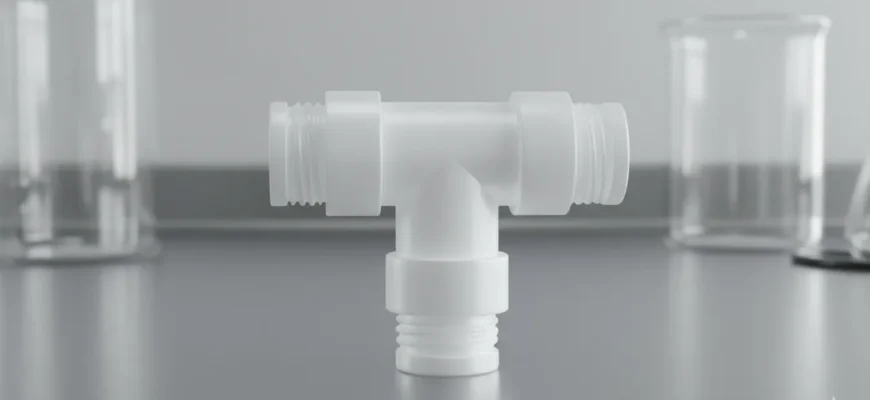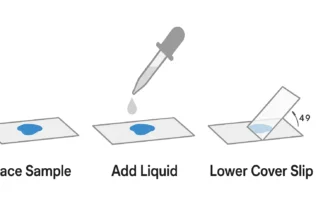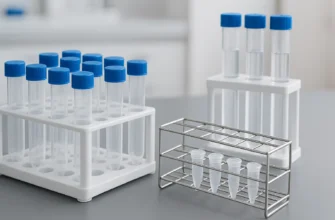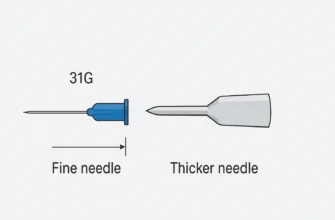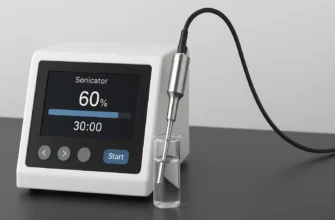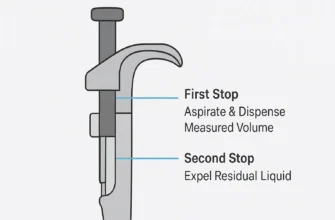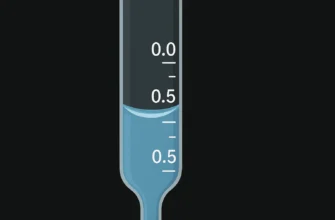Branching Out with Confidence
In laboratories, workshops, and industrial settings, the need to split, merge, or divert the flow of liquids and gases is constant. A single misplaced or failed connection can lead to leaks, contamination, and costly downtime. The humble T-shaped tube connector is the cornerstone of these branching fluid systems, but its simplicity belies the critical importance of selecting the right one. A mismatched size, an incompatible material, or an improper type can compromise the integrity of an entire setup. This guide is designed to eliminate that uncertainty, providing a clear path to choosing the perfect T-shaped connector for any application.
The Ubiquitous T-Shaped Connector: A Foundation for Fluid Systems
At its core, a T-shaped tube connector, or tee fitting, is a simple yet indispensable component used to create a 3-way connection in a tubing line. It allows a single line to be split into two separate streams or for two lines to merge into one. This fundamental capability makes it a foundational element in countless systems, from complex chemical processing manifolds and medical devices to simple aquarium aeration setups and irrigation systems.
The pipe fittings market, a testament to the importance of such components, reached a value of USD 16.8 billion in 2023 and is projected to continue growing at a CAGR of 4.5%, reaching USD 22.4 billion by 2030. Meanwhile, the broader connector market is experiencing even more robust growth, valued at USD 87.03 billion in 2024 and projected to reach USD 147.44 billion by 2032, exhibiting a CAGR of 7.1%. This underscores the widespread reliance on reliable connections across industries.
Why Choosing the Right T-Connector Matters: Preventing Leaks and Failures
Selecting the correct T-connector is not merely about functionality; it’s about reliability and safety. An improperly chosen fitting can lead to a host of problems. A loose fit results in leaks, wasting valuable materials and potentially creating hazardous conditions. A material that isn’t resistant to the chemicals being used will degrade, leading to system failure and contamination. In high-pressure applications, the wrong connector can fail catastrophically, with flows to 20 p.s.i. being common operational requirements. Each connector is a potential point of failure, and ensuring its suitability is the first line of defense against system-wide issues.
What This Guide Will Cover: Type, Material, Size, and Application
This essential guide will demystify the selection process. We will dissect the anatomy of a T-shaped connector, explore the critical properties of common materials like chemical-resistant polypropylene, and provide a step-by-step method for accurately sizing a connector to your tubing. We will also examine different connector types, from barbed tee connectors for flexible tubing to threaded connectors for rigid systems, ensuring you have the knowledge to branch out with confidence in any application.
Understanding T-Shaped Tube Connectors: Design and Function
The two primary types of T-connectors are barbed fittings that use ridges to grip flexible tubing, while threaded fittings screw onto rigid pipes for a secure, high-pressure seal. To choose the right T-connector, one must first understand its basic design and the terminology used to describe its features. This knowledge forms the basis for making an informed decision that ensures a secure, leak-proof tubing connection.
What is a T-Shaped Connector? A 3-Way Connection Explained
A T-shaped connector is a fitting with three openings, or ports, arranged in the shape of a “T.” Two ports are in-line, forming a straight-through channel, while the third port is on a branch at a 90-degree angle. This configuration allows for the simple division or combination of fluid flow within a system, making it an indispensable component for creating parallel lines or tapping into a main fluid path.
Key Components and Terminology: Decoding Connector Anatomy
Understanding the language of connectors is crucial. The main body of the fitting provides the structure and channels for flow. Each of the three ends is a “port,” designed to connect to tubing. The internal channel is the “bore,” with bore mm measurements dictating the flow capacity. The overall length is critical for ensuring proper fit within available space.
Barbs, Serrated Ends, and Gripping Power: How Connections are Secured
For flexible tubing, the most common connection method involves barbs. Serrated ends are a series of ridges that extend from the ports. When tubing is pushed over these barbs, they create a tight seal. The sharp edges of the barbs dig slightly into the inner wall of the tubing, generating immense gripping power and preventing the tube from slipping off under pressure or movement. This direct contact between the barbs and the tubing creates a reliable, leak-proof connection without the need for clamps in many low-pressure applications.
Essential Dimensions: Inner Diameter, Outer Diameter, and Measurements
Accurate selection hinges on understanding key dimensions. The most critical measurement is the Inner Diameter (ID) of the tubing the connector will be used with. The connector’s port size is designed to match this ID. Other relevant dimensions include the bore size (often measured in millimeters), the outer diameter (OD) of the ports, and the overall length and height of the fitting. For specialized applications, nominal O.D. and valley/crest O.D. measurements may be required for corrugated tubing.
Navigating Material Choices: Durability, Resistance & Application
The material of a T-connector dictates its chemical resistance, temperature tolerance, pressure rating, and suitability for specific applications. Choosing the wrong material can lead to rapid degradation and system failure.
Polypropylene and Plastics: Versatility, Chemical Resistance, and Autoclavability
Polypropylene T-shaped connectors are among the most common and versatile materials for tube connectors. This thermoplastic polymer is prized for its excellent balance of properties: it is lightweight, durable, and cost-effective. One of its most significant advantages is its broad chemical resistance.
Autoclavable polypropylene grades can be sterilized with high-pressure steam at 121°C (250°F) at 15 psi for 20 minutes. This makes them critical for laboratory supplies, medical, and pharmaceutical applications where sterility is paramount.
Chemical-Resistant Polypropylene: Ideal for Liquids, Gases, and Corrosive Environments
The molecular structure of chemical-resistant polypropylene makes it inert to a wide range of chemicals, including many acids, alkalis, and organic solvents. This makes it an ideal choice for systems transferring a variety of liquids and gases. Whether in a chemical dosing system, a fluid transfer line in a lab, or a water pipe system, polypropylene provides a reliable barrier against corrosion and material breakdown, ensuring the purity of the medium and the longevity of the fitting.
FDA-Grade Materials: Ensuring Safety for Food, Drugs, and Cosmetics
For applications involving consumable products, material safety is paramount. Connectors made from FDA-grade materials, often a specific virgin grade of polypropylene, are certified to be non-toxic and non-leaching. This ensures they are safe for direct contact with food, beverages, pharmaceuticals, and cosmetics. Using an FDA-grade fitting is a non-negotiable requirement in these industries to prevent contamination and comply with health regulations.
Metals: Copper and Electroplated Materials for Stability and High-Pressure Needs
While plastics dominate many applications, metal connectors are essential for systems requiring higher pressure ratings, greater temperature tolerance, or increased rigidity. Copper and electroplated materials offer superior mechanical strength and stability. These materials can provide the strength of a base metal with an added layer of corrosion resistance. They are typically used in plumbing, hydraulic, and pneumatic systems where the operational demands exceed the capabilities of plastic fittings.
Material Selection Checklist: Matching Properties to Your Application
To choose the right material, consider the following:
Chemical Compatibility: Will the connector be exposed to corrosive chemicals? Check a compatibility chart for your specific media.
Temperature Range: What are the minimum and maximum operating temperatures the fitting will experience? Polypropylene typically operates between 0°C to 135°C.
Pressure Requirements: Does the system operate under significant pressure or vacuum? Metal fittings can handle pressures up to 10,000 PSI in specialized applications.
Sterilization Needs: Is the application sterile? If so, an autoclavable material like polypropylene is necessary.
Regulatory Compliance: Does the application involve food, drugs, or medical use? If so, select an FDA-grade material.
Selecting the Correct Connector Type: Beyond Just a “T”
While the “T” shape defines the function, the method of connection defines the type. Different T-connectors are designed for specific types of tubing and system requirements, from flexible hoses to rigid pipes.
Barbed Tee Connectors: The Go-To for Flexible Tubing
Barbed tee connectors are the standard for connecting flexible tubing like silicone, PVC, or rubber. The design is simple and effective: the user pushes the tubing over the serrated connecting surfaces. The assembly process is straightforward, and the sharp edges provide strong gripping power, creating a secure seal that is often sufficient for low-to-moderate pressure applications without the need for external clamps.
Achieving Leak-Proof Tubing Connections with Barbed Tees: The Role of Tubing Elasticity
The success of a barbed fitting relies on the elasticity of the tubing. The Inner Diameter of the tube should be slightly smaller than the outer diameter of the largest barb. As the tube is pushed on, it stretches over the barb and then contracts, creating a tight, 360-degree seal. This tension, combined with the gripping action of the barbs, forms a robust and leak-proof tubing connection.
Compression Fittings: For Robust, High-Pressure, and Vibration-Prone Systems
For applications with high pressure, vibration, or where a more secure connection is needed, compression T-fittings are used. These connectors typically feature a nut and a ferrule (or sleeve). As the nut is tightened, it compresses the ferrule onto the tubing, creating an extremely strong and leak-proof seal. They are commonly used with semi-rigid or rigid tubing and are a staple in hydraulic and pneumatic systems, capable of handling pressures exceeding 5,000 PSI.
Threaded T-Connectors: Integrating into Rigid Pipe Systems
When a branch line needs to be added to a rigid piping system, threaded T-connectors are the solution. These fittings have threaded ports (e.g., NPT, BSP, G1/2 thread) that screw onto corresponding male-threaded pipes or other fittings. They provide a strong, permanent connection and are fundamental in plumbing and industrial piping infrastructure.
Stepped Tubing Connectors: Adapting to Varied Tubing Inner Diameters
In some cases, a system may require connecting tubes of different sizes. Stepped tubing connectors serve this purpose, with one or more ports having a different diameter than the others. This allows for a smooth transition between tubing sizes without needing additional adapters, simplifying the system design.
Specialized T-Connectors: From Pipe Sleeves to Trampoline Applications
The versatile T-shape finds uses beyond fluid handling. Specialized T-connectors are designed for structural applications, such as connecting enclosure poles for frameworks, shelving units, or even as trampoline pole caps for trampoline safety enclosure systems. While their function is structural rather than for fluid conveyance, they share the same fundamental three-way connection principle.
The Critical Step: Sizing Your T-Connector Correctly
Even with the right material and type, a T-connector will fail if it is not sized correctly. An accurate match between the connector and the tubing is the single most important factor in achieving a secure, leak-proof seal.
Understanding Tubing Dimensions: Essential Measurements
To size a connector, you must first understand tubing dimensions:
Inner Diameter (ID): The most critical measurement for barbed fittings. The connector size must match the tubing I.d.
Outer Diameter (OD): The measurement of the outside of the tube. This is critical for compression fittings.
Nominal O.D.: A standardized size designation that may not be the exact measurement.
Valley/Crest O.D.: For corrugated tubing, these are the measurements at the thinnest and thickest points.
How to Accurately Measure Your Tubing: Practical Tips for a Perfect Match
The most reliable way to measure tubing is with digital calipers. To measure the Inner Diameter, gently insert the internal jaws of the caliper inside the tube and open them until they touch the inner walls. For the Outer Diameter, use the main jaws on the outside of the tube. If calipers are unavailable, a precise ruler can be used, but this method is less accurate and should be used with caution.
The Importance of a Snug Fit: Ensuring Stability and Preventing Leaks
For a barbed connector, the goal is an interference fit. The largest diameter of the barb should be slightly larger than the tubing’s ID. This forces the tubing to stretch, maximizing the gripping power and creating a tight seal. A connector that is too small will be loose and leak, while one that is excessively large may be impossible to install or could split the tubing.
Common Tubing and Connector Sizes: Standard Measurements
Connectors are available in a vast range of standard sizes, both imperial (inches) and metric (millimeters). Common sizes you will frequently encounter include:
1/4 Inch Tubing: Approximately 6.35mm ID
6mm Tubing: Standard metric size
5/32″ (4mm): Common smaller diameter applications
It is crucial not to mix and match imperial and metric components unless their actual measured dimensions are confirmed to be compatible.
Sizing Reference Guide: Matching Connectors to Common Tubing
Always refer to manufacturer specifications. A typical sizing approach:
For 1/4″ ID Tubing: Select a connector designated for 1/4″ or 6.4mm tubing
For 6mm ID Tubing: Select a connector designated specifically for 6mm
For 4mm ID Tubing: Select a connector designated for 5/32″ or 4mm
When in doubt, it is better to have a slightly tighter fit than a loose one.
T-Connectors in Action: Diverse Applications Across Industries
The principles of proper selection apply across a surprisingly broad spectrum of industries. In research laboratories, autoclavable polypropylene tees are essential for creating manifolds for chemical reagents and buffer solutions. Laboratory applications include vacuum bottle-top filters, peristaltic pumps, and capsule filters in vacuum units.
In the food and beverage industry, FDA-grade T-connectors are used to divert product flow on processing lines. In aquaponics and hydroponics, they build complex irrigation networks. Medical applications utilize them in filtration vacuum systems and laboratory tubing setups.
Industrial applications span from solar air conditioning systems to complex water pipe systems. Even consumer products, from pneumatic systems in office chairs to aquarium air pumps, rely on T-connectors to direct the flow of liquids and gases.
The versatility extends to structural applications, where T-connectors serve as pipe sleeves for framework construction, trampoline models requiring trampoline supplies, and various enclosure poles systems.
Installation Best Practices and Safety Considerations
Proper Installation Process
The installation process is critical for achieving leak-proof tubing connections:
-
Preparation: Ensure all components are clean and free from debris
-
Tube Cutting: Use a tube cutter for clean, square cuts without burrs
-
Assembly: For barbed fittings, push tubing firmly over barbs until fully seated
-
Alignment: Ensure proper alignment before final tightening
-
Torque Application: For threaded connections, follow manufacturer specifications
Pressure Testing and Quality Assurance
After installation, systems should be pressure tested to verify leak-proof performance. Start with low pressure and gradually increase to operational levels while monitoring for leaks.
Maintenance and Inspection Guidelines
Regular inspection of T-connectors includes:
-
Visual examination for cracks or wear
-
Checking for loose connections
-
Monitoring for leaks during operation
-
Replacing components that show signs of degradation
Conclusion
Choosing the right T-shaped tube connector is a process of careful consideration, not guesswork. By systematically evaluating your application’s needs, you can ensure a reliable, safe, and efficient fluid handling system.
The selection process boils down to four key pillars:
Material: Match the material to the chemical, temperature, and pressure demands. For general-purpose use with a wide range of liquids and gases, chemical-resistant polypropylene is often the superior choice, especially when sterilization via an autoclavable process is required.
Type: Select the connection style based on your tubing. Use barbed fittings for flexible tubing and threaded or compression types for rigid pipes and high-pressure systems.
Size: This is the most critical step. Accurately measure your tubing’s Inner Diameter and select a connector that provides a snug, interference fit to maximize gripping power and prevent leaks.
Application: Consider special requirements, such as the need for FDA-grade materials for food contact, higher pressure ratings for industrial use, or autoclavable properties for sterile applications.
Before making a final purchase, consider factors like original price, current price, required quantity, pack size, and experiences found in product reviews. Leading suppliers include United Scientific Supplies, Fisher Scientific, Goldleaf Scientific Equipment, and Med Lab Supply, often offering promotional pricing, contract pricing, and dedicated account numbers for frequent users.
By following this structured approach, you can move beyond simply buying a fitting and instead engineer a robust connection point that enhances the integrity of your entire system. Whether you’re working with laboratory supplies requiring quick installation, industrial systems needing high-pressure capabilities, or specialized applications requiring FDA-grade materials, the right T-shaped connector will provide years of reliable, leak-proof service.

